

Compact Muon Solenoid
LHC, CERN
| CMS-SMP-21-013 ; CERN-EP-2022-092 | ||
| Observation of same-sign WW production from double parton scattering in proton-proton collisions at $ \sqrt{s} = $ 13 TeV | ||
| CMS Collaboration | ||
| 6 June 2022 | ||
| Phys. Rev. Lett. 131 (2023) 091803 | ||
| Abstract: The first observation of the production of W$^{\pm}$W$^{\pm} $ bosons from double parton scattering processes using same-sign electron-muon and dimuon events in proton-proton collisions is reported. The data sample corresponds to an integrated luminosity of 138 fb$ ^{-1} $ recorded at a center-of-mass energy of 13 TeV using the CMS detector at the CERN LHC. Multivariate discriminants are used to distinguish the signal process from the main backgrounds. A binned maximum likelihood fit is performed to extract the signal cross section. The measured cross section for production of same-sign W bosons decaying leptonically is 80.7 $ \pm $ 11.2 (stat) $ ^{+9.5}_{-8.6} $ (syst) $ \pm $ 12.1 (model) fb, whereas the measured fiducial cross section is 6.28 $ \pm $ 0.81 (stat) $ \pm $ 0.69 (syst) $ \pm $ 0.37 (model) fb. The observed significance of the signal is 6.2 standard deviations above the background-only hypothesis. | ||
| Links: e-print arXiv:2206.02681 [hep-ex] (PDF) ; CDS record ; inSPIRE record ; HepData record ; Physics Briefing ; CADI line (restricted) ; | ||
| Figures | Summary | Additional Figures | References | CMS Publications |
|---|
| Figures | |

png pdf |
Figure 1:
Example Feynman diagrams for leptonically decaying W$^{\pm}$W$^{\pm} $ bosons produced via DPS (upper) and SPS (middle and lower) processes. |

png pdf |
Figure 1-a:
Example Feynman diagram for leptonically decaying W$^{\pm}$W$^{\pm} $ bosons produced via a DPS process. |
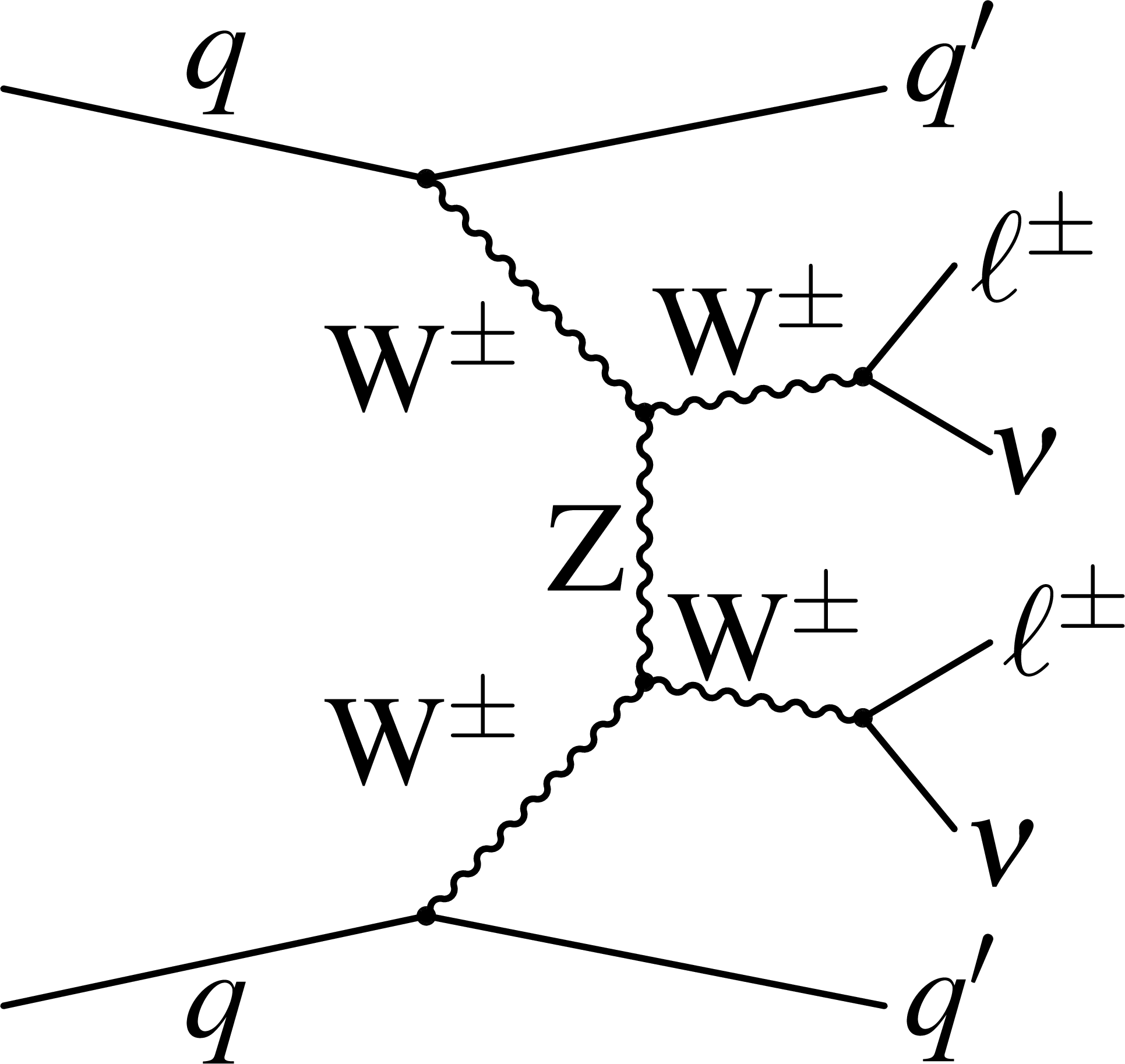
png pdf |
Figure 1-b:
Example Feynman diagram for leptonically decaying W$^{\pm}$W$^{\pm} $ bosons produced via a SPS process. |

png pdf |
Figure 1-c:
Example Feynman diagram for leptonically decaying W$^{\pm}$W$^{\pm} $ bosons produced via a SPS process. |
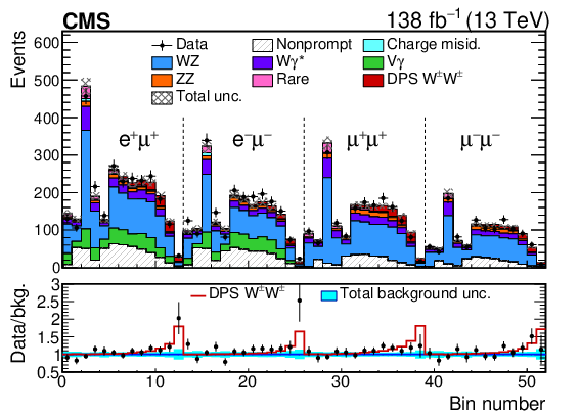
png pdf |
Figure 2:
Postfit distribution of the final BDT discriminant output for the four lepton flavor and sign categories. The SPS W$^{\pm}$W$^{\pm} $, $ \rm \mathrm{t}\overline{\mathrm{t}}} $V, and VVV contributions are grouped as the ``Rare'' background. The total postfit uncertainty in the signal and background predictions is shown as the hatched band. The bottom panels show the ratio of data to the sum of all background contributions as the black data points along with the extracted signal shown by the red line. The vertical error bars on the data points represent the statistical uncertainty of the data. |
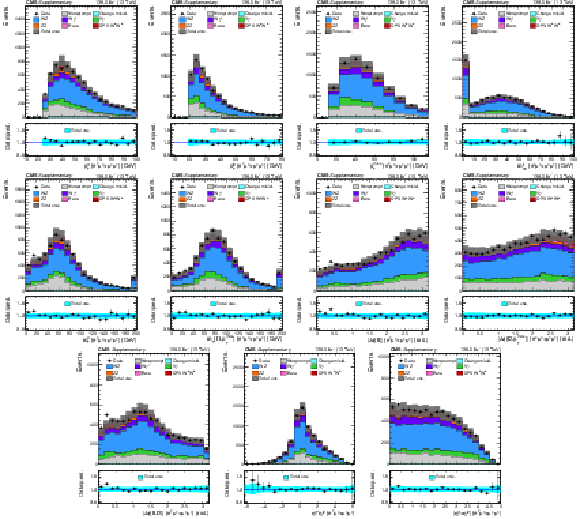
png pdf |
Figure A1:
Distributions of the kinematic variables used for the training of the BDT discriminants for the combined $ \mathrm{e}^{\pm}\mu^{\pm} $ and $ \mu^{\pm}\mu^{\pm} $ final states: $ p_{\mathrm{T}}^{\ell{1}} $, $ p_{\mathrm{T}}^{\ell{2}} $, $ p_{\mathrm{T}}^\text{miss} $, $ m_{\mathrm{T2}}(\ell\ell) $, $ m_{\mathrm{T}}\,(\ell\ell) $, $ m_{\mathrm{T}}\,(\ell{1},p_{\mathrm{T}}^\text{miss}) $, $ |\Delta\phi\,(\ell\ell)| $, $ |\Delta\phi\,(\ell{2},p_{\mathrm{T}}^\text{miss})| $, $ |\Delta\phi\,(\ell\ell,\ell{2})| $, $ \eta^{\ell{1}}*\eta^{\ell{2}} $, and, $ |\eta^{\ell{1}} + \eta^{\ell{2}}| $. The signal and background yields have been normalized to their respective postfit yields. The uncertainty bands represent the total expected uncertainty on the predicted yields, which includes both the statistical and systematic components. |

png pdf |
Figure A1-a:
Distribution of $ p_{\mathrm{T}}^{\ell{1}} $, for the combined $ \mathrm{e}^{\pm}\mu^{\pm} $ and $ \mu^{\pm}\mu^{\pm} $ final states. The signal and background yields have been normalized to their respective postfit yields. The uncertainty bands represent the total expected uncertainty on the predicted yields, which includes both the statistical and systematic components. |
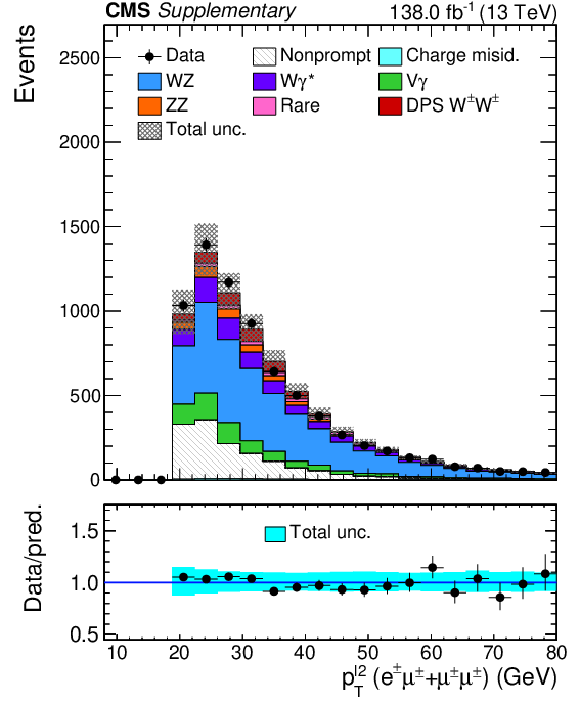
png pdf |
Figure A1-b:
Distribution of $ p_{\mathrm{T}}^{\ell{2}} $, for the combined $ \mathrm{e}^{\pm}\mu^{\pm} $ and $ \mu^{\pm}\mu^{\pm} $ final states. The signal and background yields have been normalized to their respective postfit yields. The uncertainty bands represent the total expected uncertainty on the predicted yields, which includes both the statistical and systematic components. |
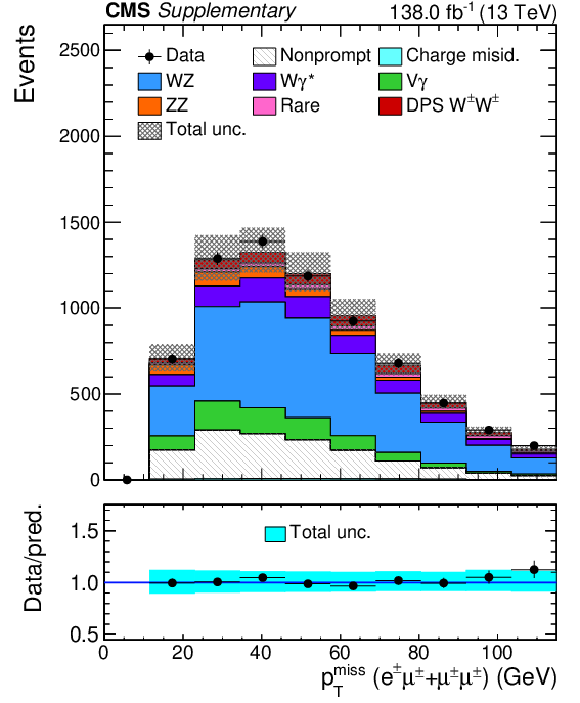
png pdf |
Figure A1-c:
Distribution of $ p_{\mathrm{T}}^\text{miss} $, for the combined $ \mathrm{e}^{\pm}\mu^{\pm} $ and $ \mu^{\pm}\mu^{\pm} $ final states. The signal and background yields have been normalized to their respective postfit yields. The uncertainty bands represent the total expected uncertainty on the predicted yields, which includes both the statistical and systematic components. |

png pdf |
Figure A1-d:
Distribution of $ m_{\mathrm{T2}}(\ell\ell) $, for the combined $ \mathrm{e}^{\pm}\mu^{\pm} $ and $ \mu^{\pm}\mu^{\pm} $ final states. The signal and background yields have been normalized to their respective postfit yields. The uncertainty bands represent the total expected uncertainty on the predicted yields, which includes both the statistical and systematic components. |
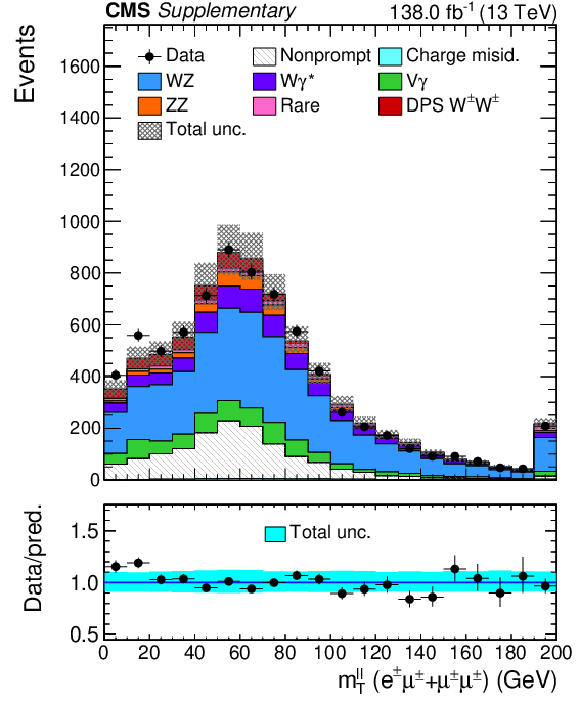
png pdf |
Figure A1-e:
Distribution of $ m_{\mathrm{T}}\,(\ell\ell) $, for the combined $ \mathrm{e}^{\pm}\mu^{\pm} $ and $ \mu^{\pm}\mu^{\pm} $ final states. The signal and background yields have been normalized to their respective postfit yields. The uncertainty bands represent the total expected uncertainty on the predicted yields, which includes both the statistical and systematic components. |

png pdf |
Figure A1-f:
Distribution of $ m_{\mathrm{T}}\,(\ell{1},p_{\mathrm{T}}^\text{miss}) $, for the combined $ \mathrm{e}^{\pm}\mu^{\pm} $ and $ \mu^{\pm}\mu^{\pm} $ final states. The signal and background yields have been normalized to their respective postfit yields. The uncertainty bands represent the total expected uncertainty on the predicted yields, which includes both the statistical and systematic components. |

png pdf |
Figure A1-g:
Distribution of $ |\Delta\phi\,(\ell\ell)| $, for the combined $ \mathrm{e}^{\pm}\mu^{\pm} $ and $ \mu^{\pm}\mu^{\pm} $ final states. The signal and background yields have been normalized to their respective postfit yields. The uncertainty bands represent the total expected uncertainty on the predicted yields, which includes both the statistical and systematic components. |

png pdf |
Figure A1-h:
Distribution of $ |\Delta\phi\,(\ell{2},p_{\mathrm{T}}^\text{miss})| $, for the combined $ \mathrm{e}^{\pm}\mu^{\pm} $ and $ \mu^{\pm}\mu^{\pm} $ final states. The signal and background yields have been normalized to their respective postfit yields. The uncertainty bands represent the total expected uncertainty on the predicted yields, which includes both the statistical and systematic components. |
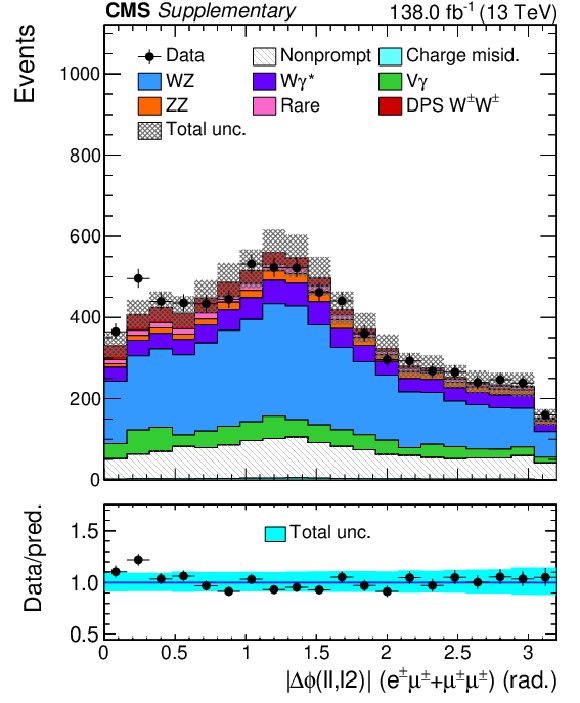
png pdf |
Figure A1-i:
Distribution of $ |\Delta\phi\,(\ell\ell,\ell{2})| $, for the combined $ \mathrm{e}^{\pm}\mu^{\pm} $ and $ \mu^{\pm}\mu^{\pm} $ final states. The signal and background yields have been normalized to their respective postfit yields. The uncertainty bands represent the total expected uncertainty on the predicted yields, which includes both the statistical and systematic components. |
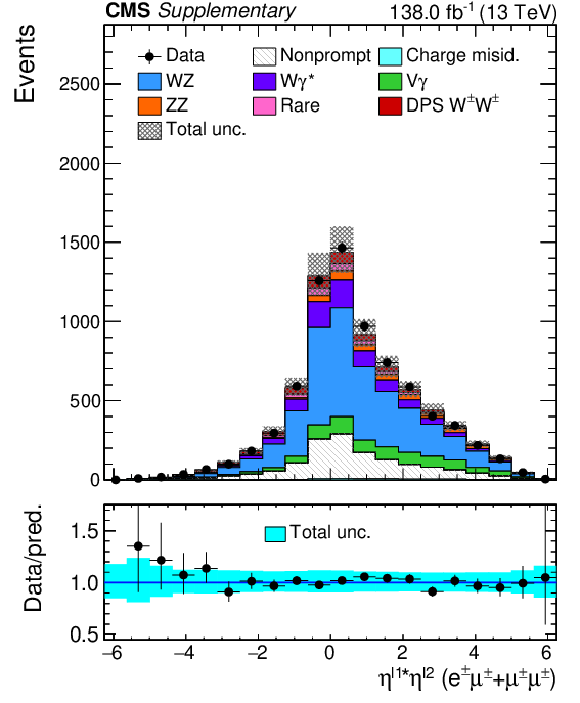
png pdf |
Figure A1-j:
Distribution of $ \eta^{\ell{1}}*\eta^{\ell{2}} $, for the combined $ \mathrm{e}^{\pm}\mu^{\pm} $ and $ \mu^{\pm}\mu^{\pm} $ final states. The signal and background yields have been normalized to their respective postfit yields. The uncertainty bands represent the total expected uncertainty on the predicted yields, which includes both the statistical and systematic components. |
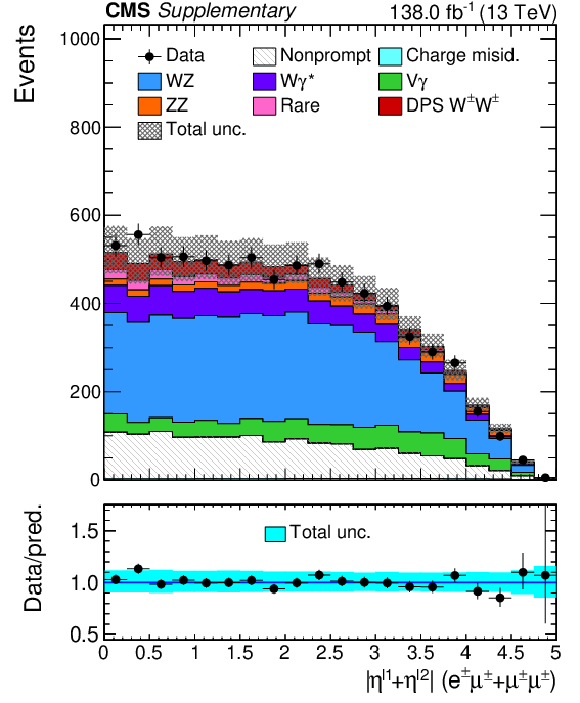
png pdf |
Figure A1-k:
Distribution of $ |\eta^{\ell{1}} + \eta^{\ell{2}}| $, for the combined $ \mathrm{e}^{\pm}\mu^{\pm} $ and $ \mu^{\pm}\mu^{\pm} $ final states. The signal and background yields have been normalized to their respective postfit yields. The uncertainty bands represent the total expected uncertainty on the predicted yields, which includes both the statistical and systematic components. |
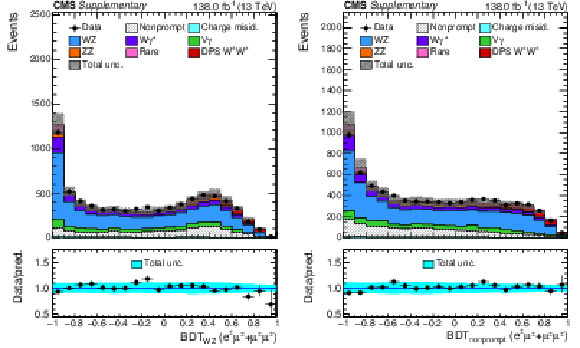
png pdf |
Figure A2:
Distributions of the two single BDT discriminants for the combined $ \mathrm{e}^{\pm}\mu^{\pm} $ and $ \mu^{\pm}\mu^{\pm} $ final states. The BDT discriminant trained against the WZ (nonprompt leptons) background is labeled as BDT$ _{\mathrm{W}\mathrm{Z}} $ (BDT$ _{\rm nonprompt} $). The signal and background yields have been normalized to their respective postfit yields. The uncertainty bands represent the total expected uncertainty on the predicted yields, which includes both the statistical and systematic components. |
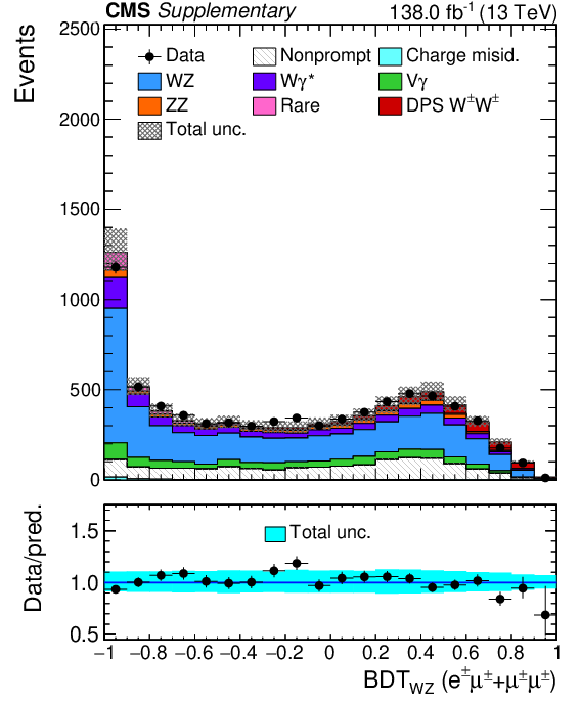
png pdf |
Figure A2-a:
Distribution of the BDT discriminant trained against the WZ background, labeled as BDT$ _{\mathrm{W}\mathrm{Z}}, for the combined $ \mathrm{e}^{\pm}\mu^{\pm} $ and $ \mu^{\pm}\mu^{\pm} $ final states. The signal and background yields have been normalized to their respective postfit yields. The uncertainty bands represent the total expected uncertainty on the predicted yields, which includes both the statistical and systematic components. |
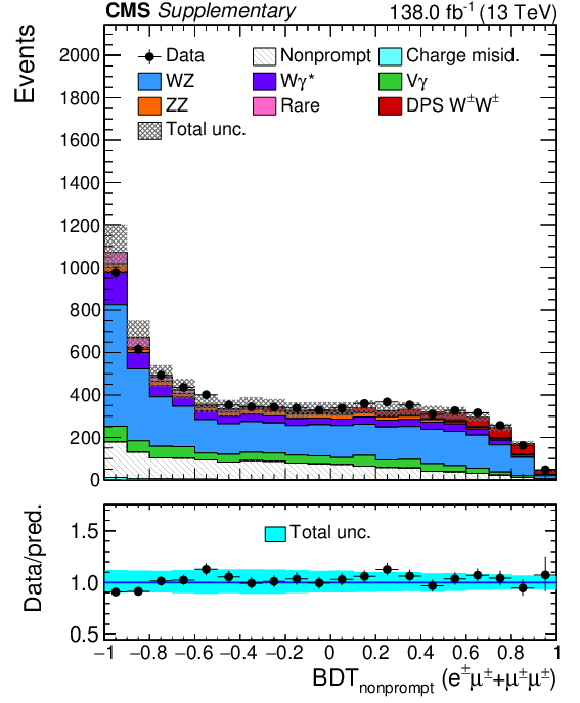
png pdf |
Figure A2-b:
Distribution of the BDT discriminant trained against the nonprompt leptons background, labeled as BDT$ _{\rm nonprompt} $, for the combined $ \mathrm{e}^{\pm}\mu^{\pm} $ and $ \mu^{\pm}\mu^{\pm} $ final states. The signal and background yields have been normalized to their respective postfit yields. The uncertainty bands represent the total expected uncertainty on the predicted yields, which includes both the statistical and systematic components. |
| Summary |
| In summary, the first observation of W$^{\pm}$W$^{\pm} $ production from double parton scattering processes in proton-proton collisions at $ \sqrt{s} = $ 13 TeV has been reported. The analyzed data set corresponds to an integrated luminosity of 138 fb$ ^{-1} $, collected in 2016--2018 using the CMS detector at the LHC. Events are selected by requiring same-sign electron-muon or dimuon pairs with moderate missing transverse momentum and low jet multiplicity. Boosted decision trees are used to discriminate between the signal and the dominant background processes. A fiducial cross section of 6.28 $ \pm $ 0.81 (stat) $ \pm $ 0.69 (syst) $ \pm $ 0.37 (model) fb is extracted, and an inclusive cross section of 80.7 $ \pm $ 11.2 (stat) $ ^{+9.5}_{-8.6} $ (syst) $ \pm $ 12.1 (model) fb is measured. This corresponds to an observed significance of the signal above the background-only hypothesis of 6.2 standard deviations. A value of the DPS effective cross section, characterizing the transverse distribution of partons in the proton, $ \sigma_{\text{eff}}= $ 12.2 $ ^{+ 2.9}_{- 2.2} $ mb is extracted. |
| Additional Figures | |

png pdf |
Additional Figure 1:
Distributions of the kinematic variables used for the training of the BDT discriminants for the combined $ \mathrm{e}^{\pm}\mu^{\pm} $ and $ \mu^{\pm}\mu^{\pm} $ final states: $ p_{\mathrm{T}}^{\ell{1}} $, $ p_{\mathrm{T}}^{\ell{2}} $, $ p_{\mathrm{T}}^\text{miss} $, $ m_{\mathrm{T2}}(\ell\ell) $, $ m_{\mathrm{T}}\,(\ell\ell) $, $ m_{\mathrm{T}}\,(\ell{1},p_{\mathrm{T}}^\text{miss}) $, $ |\Delta\phi\,(\ell\ell)| $, $ |\Delta\phi\,(\ell{2},p_{\mathrm{T}}^\text{miss})| $, $ |\Delta\phi\,(\ell\ell,\ell{2})| $, $ \eta^{\ell{1}}\times\eta^{\ell{2}} $, and, $ |\eta^{\ell{1}} + \eta^{\ell{2}}| $. The signal and background yields have been normalized to their respective postfit yields. The uncertainty bands represent the total expected uncertainty on the predicted yields, which includes both the statistical and systematic components. |

png pdf |
Additional Figure 1-a:
Distribution of $ p_{\mathrm{T}}^{\ell{1}} $ for the combined $ \mathrm{e}^{\pm}\mu^{\pm} $ and $ \mu^{\pm}\mu^{\pm} $ final states. This variable is used for the training of the BDT discriminants $ p_{\mathrm{T}}^{\ell{1}} $. The signal and background yields have been normalized to their respective postfit yields. The uncertainty bands represent the total expected uncertainty on the predicted yields, which includes both the statistical and systematic components. |

png pdf |
Additional Figure 1-b:
Distribution of $ p_{\mathrm{T}}^{\ell{2}} $ for the combined $ \mathrm{e}^{\pm}\mu^{\pm} $ and $ \mu^{\pm}\mu^{\pm} $ final states. This variable is used for the training of the BDT discriminants $ p_{\mathrm{T}}^{\ell{1}} $. The signal and background yields have been normalized to their respective postfit yields. The uncertainty bands represent the total expected uncertainty on the predicted yields, which includes both the statistical and systematic components. |

png pdf |
Additional Figure 1-c:
Distribution of $ p_{\mathrm{T}}^\text{miss} $ for the combined $ \mathrm{e}^{\pm}\mu^{\pm} $ and $ \mu^{\pm}\mu^{\pm} $ final states. This variable is used for the training of the BDT discriminants $ p_{\mathrm{T}}^{\ell{1}} $. The signal and background yields have been normalized to their respective postfit yields. The uncertainty bands represent the total expected uncertainty on the predicted yields, which includes both the statistical and systematic components. |

png pdf |
Additional Figure 1-d:
Distribution of $ m_{\mathrm{T2}}(\ell\ell) $ for the combined $ \mathrm{e}^{\pm}\mu^{\pm} $ and $ \mu^{\pm}\mu^{\pm} $ final states. This variable is used for the training of the BDT discriminants $ p_{\mathrm{T}}^{\ell{1}} $. The signal and background yields have been normalized to their respective postfit yields. The uncertainty bands represent the total expected uncertainty on the predicted yields, which includes both the statistical and systematic components. |
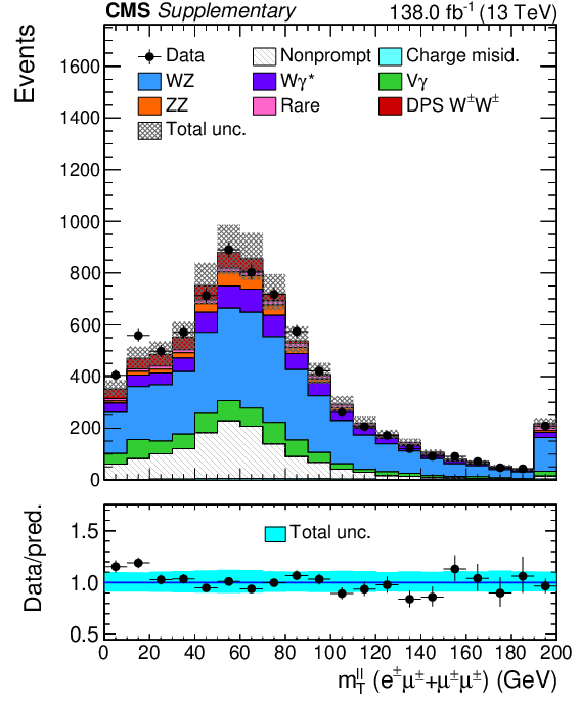
png pdf |
Additional Figure 1-e:
Distribution of $ m_{\mathrm{T}}\,(\ell\ell) $ for the combined $ \mathrm{e}^{\pm}\mu^{\pm} $ and $ \mu^{\pm}\mu^{\pm} $ final states. This variable is used for the training of the BDT discriminants $ p_{\mathrm{T}}^{\ell{1}} $. The signal and background yields have been normalized to their respective postfit yields. The uncertainty bands represent the total expected uncertainty on the predicted yields, which includes both the statistical and systematic components. |
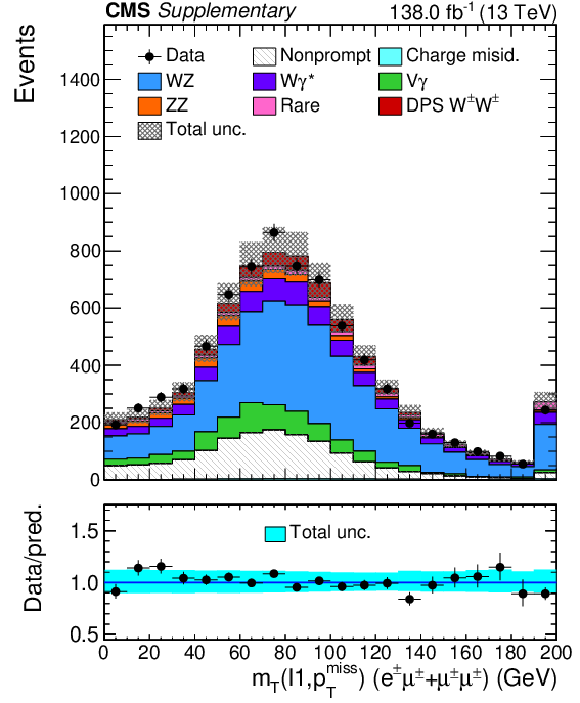
png pdf |
Additional Figure 1-f:
Distribution of $ m_{\mathrm{T}}\,(\ell{1},p_{\mathrm{T}}^\text{miss}) $ for the combined $ \mathrm{e}^{\pm}\mu^{\pm} $ and $ \mu^{\pm}\mu^{\pm} $ final states. This variable is used for the training of the BDT discriminants $ p_{\mathrm{T}}^{\ell{1}} $. The signal and background yields have been normalized to their respective postfit yields. The uncertainty bands represent the total expected uncertainty on the predicted yields, which includes both the statistical and systematic components. |
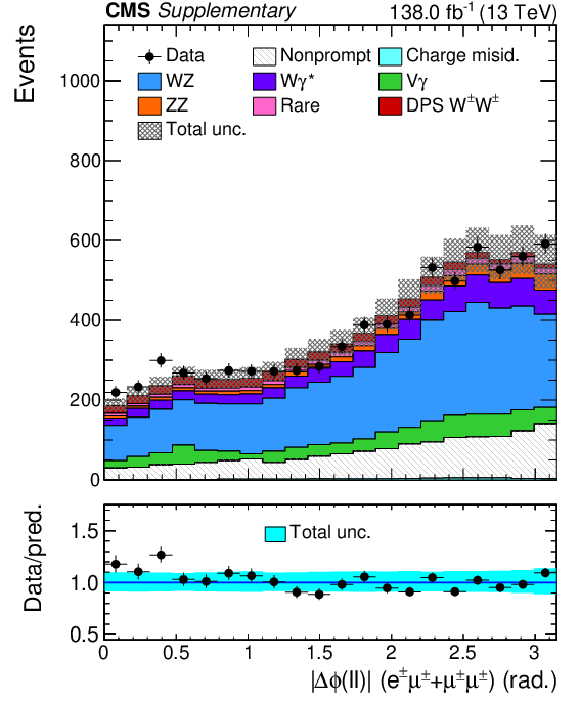
png pdf |
Additional Figure 1-g:
Distribution of $ |\Delta\phi\,(\ell\ell)| $ for the combined $ \mathrm{e}^{\pm}\mu^{\pm} $ and $ \mu^{\pm}\mu^{\pm} $ final states. This variable is used for the training of the BDT discriminants $ p_{\mathrm{T}}^{\ell{1}} $. The signal and background yields have been normalized to their respective postfit yields. The uncertainty bands represent the total expected uncertainty on the predicted yields, which includes both the statistical and systematic components. |

png pdf |
Additional Figure 1-h:
Distribution of $ |\Delta\phi\,(\ell{2},p_{\mathrm{T}}^\text{miss})| $ for the combined $ \mathrm{e}^{\pm}\mu^{\pm} $ and $ \mu^{\pm}\mu^{\pm} $ final states. This variable is used for the training of the BDT discriminants $ p_{\mathrm{T}}^{\ell{1}} $. The signal and background yields have been normalized to their respective postfit yields. The uncertainty bands represent the total expected uncertainty on the predicted yields, which includes both the statistical and systematic components. |

png pdf |
Additional Figure 1-i:
Distribution of $ |\Delta\phi\,(\ell\ell,\ell{2})| $ for the combined $ \mathrm{e}^{\pm}\mu^{\pm} $ and $ \mu^{\pm}\mu^{\pm} $ final states. This variable is used for the training of the BDT discriminants $ p_{\mathrm{T}}^{\ell{1}} $. The signal and background yields have been normalized to their respective postfit yields. The uncertainty bands represent the total expected uncertainty on the predicted yields, which includes both the statistical and systematic components. |
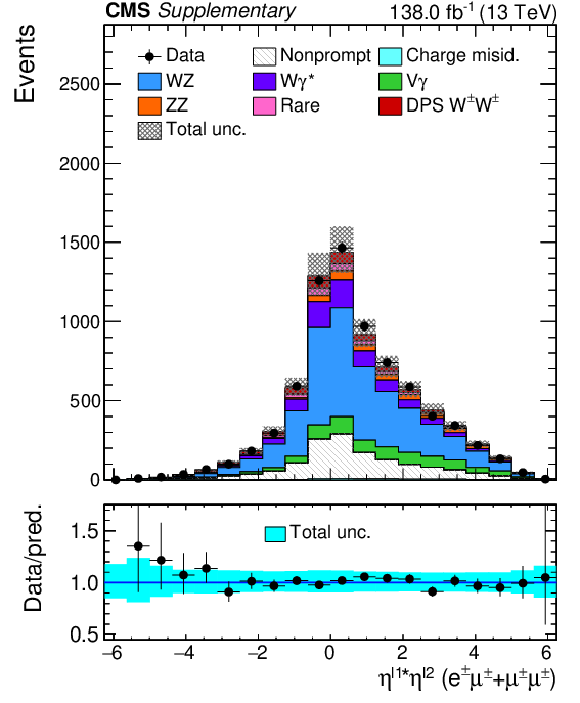
png pdf |
Additional Figure 1-j:
Distribution of $ \eta^{\ell{1}}\times\eta^{\ell{2}} $ for the combined $ \mathrm{e}^{\pm}\mu^{\pm} $ and $ \mu^{\pm}\mu^{\pm} $ final states. This variable is used for the training of the BDT discriminants $ p_{\mathrm{T}}^{\ell{1}} $. The signal and background yields have been normalized to their respective postfit yields. The uncertainty bands represent the total expected uncertainty on the predicted yields, which includes both the statistical and systematic components. |
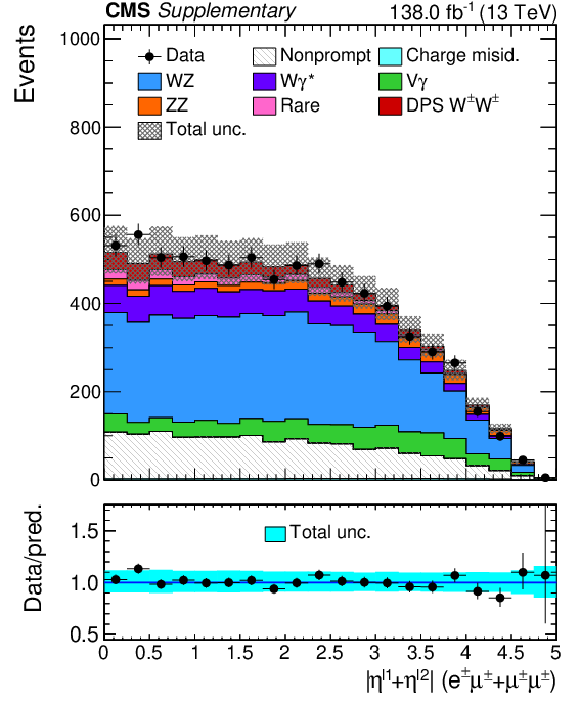
png pdf |
Additional Figure 1-k:
Distribution of $ |\eta^{\ell{1}} + \eta^{\ell{2}}| $ for the combined $ \mathrm{e}^{\pm}\mu^{\pm} $ and $ \mu^{\pm}\mu^{\pm} $ final states. This variable is used for the training of the BDT discriminants $ p_{\mathrm{T}}^{\ell{1}} $. The signal and background yields have been normalized to their respective postfit yields. The uncertainty bands represent the total expected uncertainty on the predicted yields, which includes both the statistical and systematic components. |

png pdf |
Additional Figure 2:
Distributions of the two single BDT discriminants for the combined $ \mathrm{e}^{\pm}\mu^{\pm} $ and $ \mu^{\pm}\mu^{\pm} $ final states. The BDT discriminant trained against the WZ (nonprompt leptons) background is labeled as BDT$ _{\mathrm{W}\mathrm{Z}} $ (BDT$ _{\rm nonprompt} $). The signal and background yields have been normalized to their respective postfit yields. The uncertainty bands represent the total expected uncertainty on the predicted yields, which includes both the statistical and systematic components. |

png pdf |
Additional Figure 2-a:
Distribution of the BDT discriminant trained against the WZ background (BDT$ _{\mathrm{W}\mathrm{Z}} $) for the combined $ \mathrm{e}^{\pm}\mu^{\pm} $ and $ \mu^{\pm}\mu^{\pm} $ final states. The signal and background yields have been normalized to their respective postfit yields. The uncertainty bands represent the total expected uncertainty on the predicted yields, which includes both the statistical and systematic components. |
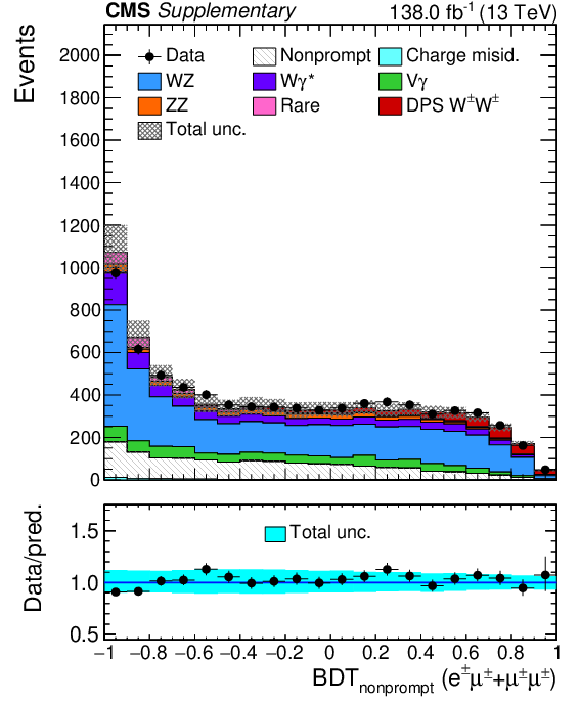
png pdf |
Additional Figure 2-b:
Distribution of the BDT discriminant trained against the nonprompt leptons background (BDT$ _{\rm nonprompt} $) for the combined $ \mathrm{e}^{\pm}\mu^{\pm} $ and $ \mu^{\pm}\mu^{\pm} $ final states. The signal and background yields have been normalized to their respective postfit yields. The uncertainty bands represent the total expected uncertainty on the predicted yields, which includes both the statistical and systematic components. |
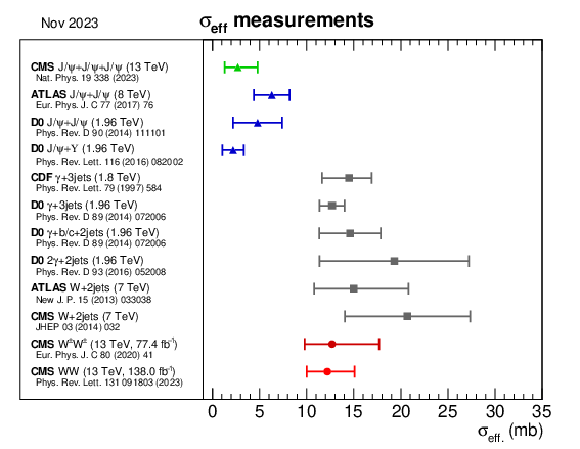
png pdf |
Additional Figure 3:
Summary of effective cross section measured using different final states at different center-of-mass energies. |
| References | ||||
| 1 | N. Paver and D. Treleani | Multiquark scattering and large-$ p_{\rm T} $ jet production in hadronic collisions | Nuovo Cim. A 70 (1982) 215 | |
| 2 | C. Goebel, D. M. Scott, and F. Halzen | Double Drell-Yan annihilations in hadron collisions: novel tests of the constituent picture | PRD 22 (1980) 2789 | |
| 3 | V. P. Shelest, A. M. Snigirev, and G. M. Zinovev | Gazing into the multiparton distribution equations in QCD | PLB 113 (1982) 325 | |
| 4 | T. Sjostrand and M. van Zijl | A multiple interaction model for the event structure in hadron collisions | PRD 36 (1987) 2019 | |
| 5 | G. Calucci and D. Treleani | Disentangling correlations in multiple parton interactions | PRD 83 (2011) 016012 | 1009.5881 |
| 6 | M. Diehl, D. Ostermeier, and A. Schafer | Elements of a theory for multiparton interactions in QCD | JHEP 03 (2012) 089 | 1111.0910 |
| 7 | B. Blok, Yu. Dokshitzer, L. Frankfurt, and M. Strikman | Perturbative QCD correlations in multi-parton collisions | EPJC 74 (2014) 2926 | 1306.3763 |
| 8 | M. Diehl and J. R. Gaunt | Double parton scattering theory overview | Adv. Ser. Direct. High Energy Phys. 29 (2018) 7 | 1710.04408 |
| 9 | P. Bartalini and J. R. Gaunt, eds. | Multiple parton interactions at the LHC | volume 29 of Advanced series on directions in high energy physics World Scientific, 2019 , ISBN 978-981-322-775-0, 978-981-322-777-4 | |
| 10 | J. R. Gaunt, C.-H. Kom, A. Kulesza, and W. J. Stirling | Same-sign W pair production as a probe of double parton scattering at the LHC | EPJC 69 (2010) 53 | 1003.3953 |
| 11 | ATLAS Collaboration | Measurement of hard double-parton interactions in W$ (\to {l\nu}) $+ 2 jet events at $ \sqrt{s} = $ 7 TeV with the ATLAS detector | New J. Phys. 15 (2013) 033038 | 1301.6872 |
| 12 | CMS Collaboration | Study of double parton scattering using W + 2-jet events in proton-proton collisions at $ \sqrt{s} = $ 7 TeV | JHEP 03 (2014) 032 | CMS-FSQ-12-028 1312.5729 |
| 13 | CDF Collaboration | Measurement of double parton scattering in $ \overline{\mathrm{p}}\mathrm{p} $ collisions at $ \sqrt{s} = $ 1.8 TeV | PRL 79 (1997) 584 | |
| 14 | CMS Collaboration | Event generator tunes obtained from underlying event and multiparton scattering measurements | EPJC 76 (2016) 155 | CMS-GEN-14-001 1512.00815 |
| 15 | D0 Collaboration | Double parton interactions in $ {\gamma}$+3 jet events in $ {\rm p}\overline{\rm p} $ collisions at $ \sqrt{s}= $ 1.96 TeV | PRD 81 (2010) 052012 | 0912.5104 |
| 16 | ATLAS Collaboration | Observation and measurements of the production of prompt and non-prompt J/$\psi $ mesons in association with a Z boson in pp collisions at $ \sqrt{s} = $ 8 TeV with the ATLAS detector | EPJC 75 (2015) 229 | 1412.6428 |
| 17 | LHCb Collaboration | Production of associated $ \Upsilon $ and open charm hadrons in pp collisions at $ \sqrt{s}= $ 7 and 8 TeV via double parton scattering | JHEP 07 (2016) 052 | 1510.05949 |
| 18 | D0 Collaboration | Evidence for simultaneous production of J/$\psi $ and $ \Upsilon $ mesons | PRL 116 (2016) 082002 | 1511.02428 |
| 19 | CMS Collaboration | Observation of triple J/$ \psi $ meson production in proton-proton collisions at $ \sqrt{s} = $ 13 TeV | 2021. Submitted to Nature Physics | CMS-BPH-21-004 2111.05370 |
| 20 | AFS Collaboration | Double parton scattering in pp collisions at $ \sqrt{s}= $ 63 GeV | Z. Phys. C 34 (1987) 163 | |
| 21 | UA2 Collaboration | A study of multi-jet events at the CERN $ \overline{\rm p} {\rm p}$ collider and a search for double parton scattering | PLB 268 (1991) 145 | |
| 22 | CDF Collaboration | Study of four-jet events and evidence for double parton interactions in ${\rm p} \overline{\rm p} $ collisions at $ \sqrt{s} = $ 1.8 TeV | PRD 47 (1993) 4857 | |
| 23 | CDF Collaboration | Double parton scattering in $ \overline{\mathrm{p}} \mathrm{p} $ collisions at $ \sqrt{s} = $ 1.8 TeV | PRD 56 (1997) 3811 | |
| 24 | LHCb Collaboration | Observation of double charm production involving open charm in pp collisions at $ \sqrt{s} = $ 7 TeV | JHEP 06 (2012) 141 | 1205.0975 |
| 25 | CMS Collaboration | Constraints on the double-parton scattering cross section from same-sign W boson pair production in proton-proton collisions at $ \sqrt{s}= $ 8 TeV | JHEP 02 (2018) 032 | CMS-FSQ-16-005 1712.02280 |
| 26 | ATLAS Collaboration | Study of the hard double-parton scattering contribution to inclusive four-lepton production in pp collisions at $ \sqrt s= $ 8 TeV with the ATLAS detector | PLB 790 (2019) 595 | 1811.11094 |
| 27 | CMS Collaboration | Measurement of double-parton scattering in inclusive production of four jets with low transverse momentum in proton-proton collisions at $ \sqrt{s} = $ 13 TeV | JHEP 01 (2022) 177 | CMS-SMP-20-007 2109.13822 |
| 28 | CMS Collaboration | Study of Z boson plus jets events using variables sensitive to double-parton scattering in pp collisions at 13 TeV | JHEP 10 (2021) 176 | CMS-SMP-20-009 2105.14511 |
| 29 | D0 Collaboration | Observation and studies of double J/$ \psi $ production at the Tevatron | PRD 90 (2014) 111101 | 1406.2380 |
| 30 | CMS Collaboration | Search for physics beyond the standard model in events with jets and two same-sign or at least three charged leptons in proton-proton collisions at $ \sqrt{s}= $ 13 TeV | EPJC 80 (2020) 752 | CMS-SUS-19-008 2001.10086 |
| 31 | A. Del Fabbro and D. Treleani | A double parton scattering background to Higgs boson production at the LHC | PRD 61 (2000) 077502 | hep-ph/9911358 |
| 32 | J. R. Gaunt and W. J. Stirling | Double parton distributions incorporating perturbative QCD evolution and momentum and quark number sum rules | JHEP 03 (2010) 005 | 0910.4347 |
| 33 | M. Diehl, J. R. Gaunt, and K. Schonwald | Double hard scattering without double counting | JHEP 06 (2017) 083 | 1702.06486 |
| 34 | M. Diehl, P. Plossl, and A. Schafer | Proof of sum rules for double parton distributions in QCD | EPJC 79 (2019) 253 | 1811.00289 |
| 35 | J. R. Gaunt and T. Kasemets | Transverse momentum dependence in double parton scattering | Adv. High Energy Phys. 2019 (2019) 3797394 | 1812.09099 |
| 36 | B. Cabouat, J. R. Gaunt, and K. Ostrolenk | A Monte Carlo simulation of double parton scattering | JHEP 11 (2019) 061 | 1906.04669 |
| 37 | A. Kulesza and W. J. Stirling | Like sign W boson production at the LHC as a probe of double parton scattering | PLB 475 (2000) 168 | hep-ph/9912232 |
| 38 | CMS Collaboration | Evidence for WW production from double-parton interactions in proton-proton collisions at $ \sqrt{s} = $ 13 TeV | EPJC 80 (2020) 41 | CMS-SMP-18-015 1909.06265 |
| 39 | CMS Collaboration | The CMS experiment at the CERN LHC | JINST 3 (2008) S08004 | CMS-00-001 |
| 40 | CMS Collaboration | Performance of the CMS Level-1 trigger in proton-proton collisions at $ \sqrt{s} = $ 13 TeV | JINST 15 (2020) P10017 | CMS-TRG-17-001 2006.10165 |
| 41 | CMS Collaboration | The CMS trigger system | JINST 12 (2017) P01020 | CMS-TRG-12-001 1609.02366 |
| 42 | CMS Collaboration | Performance of electron reconstruction and selection with the CMS detector in proton-proton collisions at $ \sqrt{s} = $ 8 TeV | JINST 10 (2015) P06005 | CMS-EGM-13-001 1502.02701 |
| 43 | CMS Collaboration | Performance of the CMS muon detector and muon reconstruction with proton-proton collisions at $ \sqrt{s}= $ 13 TeV | JINST 13 (2018) P06015 | CMS-MUO-16-001 1804.04528 |
| 44 | CMS Collaboration | Performance of photon reconstruction and identification with the CMS detector in proton-proton collisions at $ \sqrt{s} = $ 8 TeV | JINST 10 (2015) P08010 | CMS-EGM-14-001 1502.02702 |
| 45 | CMS Collaboration | Description and performance of track and primary-vertex reconstruction with the CMS tracker | JINST 9 (2014) P10009 | CMS-TRK-11-001 1405.6569 |
| 46 | CMS Collaboration | Particle-flow reconstruction and global event description with the CMS detector | JINST 12 (2017) P10003 | CMS-PRF-14-001 1706.04965 |
| 47 | CMS Collaboration | Performance of reconstruction and identification of $ \tau $ leptons decaying to hadrons and $ \nu_{\tau} $ in pp collisions at $ \sqrt{s}= $ 13 TeV | JINST 13 (2018) P10005 | CMS-TAU-16-003 1809.02816 |
| 48 | CMS Collaboration | Jet energy scale and resolution in the CMS experiment in pp collisions at 8 TeV | JINST 12 (2017) P02014 | CMS-JME-13-004 1607.03663 |
| 49 | CMS Collaboration | Performance of missing transverse momentum reconstruction in proton-proton collisions at $ \sqrt{s} = $ 13 TeV using the CMS detector | JINST 14 (2019) P07004 | CMS-JME-17-001 1903.06078 |
| 50 | M. Cacciari, G. P. Salam, and G. Soyez | The anti-$ {k_{\mathrm{T}}} $ jet clustering algorithm | JHEP 04 (2008) 063 | 0802.1189 |
| 51 | M. Cacciari, G. P. Salam, and G. Soyez | FastJet user manual | EPJC 72 (2012) 1896 | 1111.6097 |
| 52 | CMS Collaboration | Pileup mitigation at CMS in 13 TeV data | JINST 15 (2020) P09018 | CMS-JME-18-001 2003.00503 |
| 53 | CMS Collaboration | Electron and photon reconstruction and identification with the CMS experiment at the CERN LHC | JINST 16 (2021) P05014 | CMS-EGM-17-001 2012.06888 |
| 54 | CMS Collaboration | Measurement of the Higgs boson production rate in association with top quarks in final states with electrons, muons, and hadronically decaying tau leptons at $ \sqrt{s} = $ 13 TeV | EPJC 81 (2021) 378 | CMS-HIG-19-008 2011.03652 |
| 55 | E. Bols et al. | Jet flavour classification using DeepJet | JINST 15 (2020) P12012 | 2008.10519 |
| 56 | CMS Collaboration | Performance of the DeepJet b tagging algorithm using 41.9 fb$ ^{-1} $ of data from proton-proton collisions at 13 TeV with Phase 1 CMS detector | CDS | |
| 57 | T. Sjostrand et al. | An introduction to PYTHIA 8.2 | CPC 191 (2015) 159 | 1410.3012 |
| 58 | M. Bahr et al. | Herwig++ physics and manual | EPJC 58 (2008) 639 | 0803.0883 |
| 59 | R. D. Ball et al. | Parton distributions with LHC data | NPB 867 (2013) 244 | 1207.1303 |
| 60 | CMS Collaboration | Extraction and validation of a new set of CMS PYTHIA8 tunes from underlying-event measurements | EPJC 80 (2020) 4 | CMS-GEN-17-001 1903.12179 |
| 61 | J. Bellm et al. | Herwig 7.0/Herwig++ 3.0 release note | EPJC 76 (2016) 196 | 1512.01178 |
| 62 | J. Pumplin et al. | New generation of parton distributions with uncertainties from global QCD analysis | JHEP 07 (2002) 012 | hep-ph/0201195 |
| 63 | NNPDF Collaboration | Parton distributions from high-precision collider data | EPJC 77 (2017) 663 | 1706.00428 |
| 64 | CMS Collaboration | Development and validation of HERWIG 7 tunes from CMS underlying-event measurements | EPJC 81 (2021) 312 | CMS-GEN-19-001 2011.03422 |
| 65 | A. D. Martin, W. J. Stirling, R. S. Thorne, and G. Watt | Heavy-quark mass dependence in global PDF analyses and 3- and 4-flavour parton distributions | EPJC 70 (2010) 51 | 1007.2624 |
| 66 | J. Alwall et al. | The automated computation of tree-level and next-to-leading order differential cross sections, and their matching to parton shower simulations | JHEP 07 (2014) 079 | 1405.0301 |
| 67 | R. Frederix and S. Frixione | Merging meets matching in MC@NLO | JHEP 12 (2012) 061 | 1209.6215 |
| 68 | P. Nason | A new method for combining NLO QCD with shower Monte Carlo algorithms | JHEP 11 (2004) 040 | hep-ph/0409146 |
| 69 | S. Frixione, P. Nason, and C. Oleari | Matching NLO QCD computations with parton shower simulations: the POWHEG method | JHEP 11 (2007) 070 | 0709.2092 |
| 70 | S. Alioli, P. Nason, C. Oleari, and E. Re | A general framework for implementing NLO calculations in shower Monte Carlo programs: the POWHEG BOX | JHEP 06 (2010) 043 | 1002.2581 |
| 71 | NNPDF Collaboration | Parton distributions with QED corrections | NPB 877 (2013) 290 | 1308.0598 |
| 72 | NNPDF Collaboration | Unbiased global determination of parton distributions and their uncertainties at NNLO and at LO | NPB 855 (2012) 153 | 1107.2652 |
| 73 | GEANT4 Collaboration | GEANT4 --- a simulation toolkit | NIMA 506 (2003) 250 | |
| 74 | CMS Collaboration | Evidence for associated production of a Higgs boson with a top quark pair in final states with electrons, muons, and hadronically decaying $ \tau $ leptons at $ \sqrt{s} = $ 13 TeV | JHEP 08 (2018) 066 | CMS-HIG-17-018 1803.05485 |
| 75 | H. Voss, A. Hocker, J. Stelzer, and F. Tegenfeldt | TMVA, the toolkit for multivariate data analysis with ROOT | in XIth International Workshop on Advanced Computing and Analysis Techniques in Physics Research (ACAT), p. 40 2007 [PoS(ACAT)040] | physics/0703039 |
| 76 | C. G. Lester and D. J. Summers | Measuring masses of semi-invisibly decaying particles pair produced at hadron colliders | PLB 463 (1999) 99 | hep-ph/9906349 |
| 77 | A. Barr, C. Lester, and P. Stephens | A variable for measuring masses at hadron colliders when missing energy is expected; m$ _{\rm T2} $: the truth behind the glamour | JPG 29 (2003) 2343 | hep-ph/0304226 |
| 78 | CMS Collaboration | Precision luminosity measurement in proton-proton collisions at $ \sqrt{s} = $ 13 TeV in 2015 and 2016 at CMS | EPJC 81 (2021) 800 | CMS-LUM-17-003 2104.01927 |
| 79 | CMS Collaboration | CMS luminosity measurement for the 2017 data-taking period at $ \sqrt{s} = $ 13 TeV | ||
| 80 | CMS Collaboration | CMS luminosity measurement for the 2018 data-taking period at $ \sqrt{s} = $ 13 TeV | ||
| 81 | CMS Collaboration | Measurement of the inelastic proton-proton cross section at $ \sqrt{s}= $ 13 TeV | JHEP 07 (2018) 161 | CMS-FSQ-15-005 1802.02613 |
| 82 | CMS Collaboration | Measurement of the inclusive and differential WZ production cross sections, polarization angles, and triple gauge couplings in pp collisions at $ \sqrt{s} = $ 13 TeV | 2021. Submitted to JHEP | CMS-SMP-20-014 2110.11231 |
| 83 | NNPDF Collaboration | Parton distributions for the LHC Run II | JHEP 04 (2015) 040 | 1410.8849 |
| 84 | J. Butterworth et al. | PDF4LHC recommendations for LHC Run II | JPG 43 (2016) 023001 | 1510.03865 |
| 85 | R. J. Barlow and C. Beeston | Fitting using finite Monte Carlo samples | CPC 77 (1993) 219 | |
| 86 | J. S. Conway | Incorporating nuisance parameters in likelihoods for multisource spectra | in PHYSTAT 2011, p. 115 2011 | 1103.0354 |
| 87 | G. Cowan, K. Cranmer, E. Gross, and O. Vitells | Asymptotic formulae for likelihood-based tests of new physics | EPJC 71 (2011) 1554 | 1007.1727 |
| 88 | ATLAS and CMS Collaborations, LHC Higgs Combination Group | Procedure for the LHC Higgs boson search combination in summer 2011 | CMS-NOTE-2011-005 | |
| 89 | CMS Collaboration | Supplemental Material | [URL will be inserted by publisher] | |
| 90 | CMS Collaboration | Precise determination of the mass of the Higgs boson and tests of compatibility of its couplings with the standard model predictions using proton collisions at 7 and 8 TeV | EPJC 75 (2015) 212 | CMS-HIG-14-009 1412.8662 |
| 91 | C. Anastasiou, L. J. Dixon, K. Melnikov, and F. Petriello | High precision QCD at hadron colliders: electroweak gauge boson rapidity distributions at NNLO | PRD 69 (2004) 094008 | hep-ph/0312266 |
| 92 | R. Gavin, Y. Li, F. Petriello, and S. Quackenbush | W physics at the LHC with FEWZ 2.1 | CPC 184 (2013) 208 | 1201.5896 |
| 93 | CMS Collaboration | HEPData record for this analysis | link | |

|
Compact Muon Solenoid LHC, CERN |

|

|

|

|

|

|